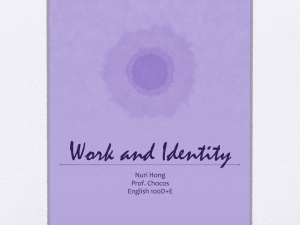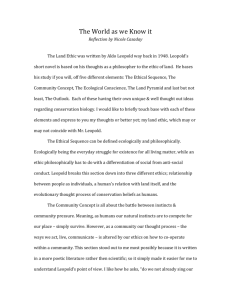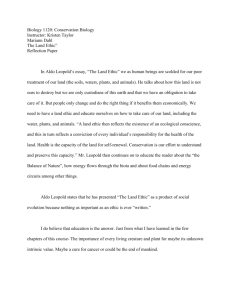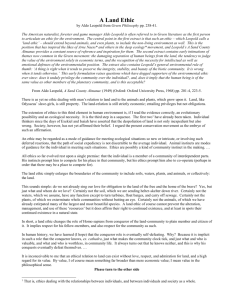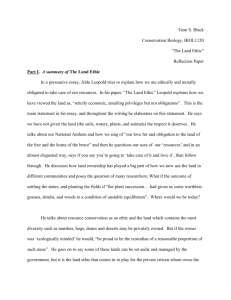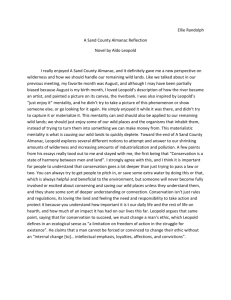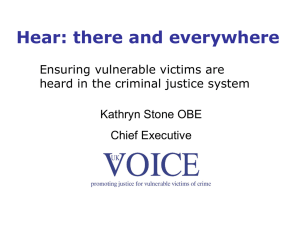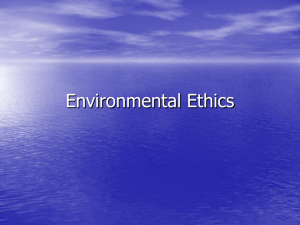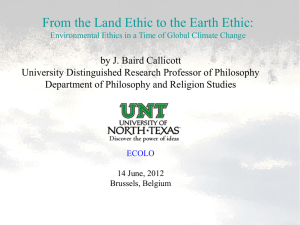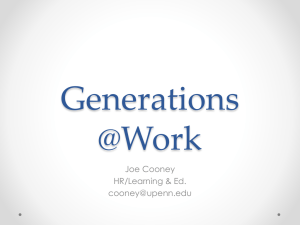8. The Land Ethic
advertisement
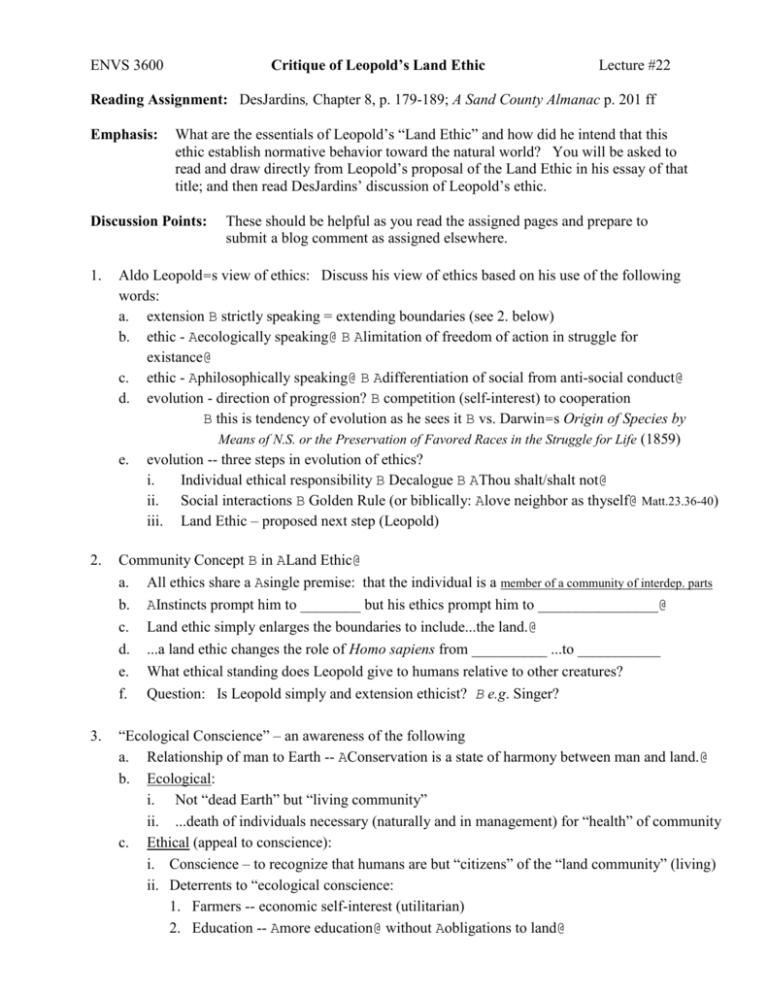
Critique of Leopold’s Land Ethic ENVS 3600 Lecture #22 Reading Assignment: DesJardins, Chapter 8, p. 179-189; A Sand County Almanac p. 201 ff Emphasis: What are the essentials of Leopold’s “Land Ethic” and how did he intend that this ethic establish normative behavior toward the natural world? You will be asked to read and draw directly from Leopold’s proposal of the Land Ethic in his essay of that title; and then read DesJardins’ discussion of Leopold’s ethic. Discussion Points: These should be helpful as you read the assigned pages and prepare to submit a blog comment as assigned elsewhere. 1. Aldo Leopold=s view of ethics: Discuss his view of ethics based on his use of the following words: a. extension B strictly speaking = extending boundaries (see 2. below) b. ethic - Aecologically speaking@ B Alimitation of freedom of action in struggle for existance@ c. ethic - Aphilosophically speaking@ B Adifferentiation of social from anti-social conduct@ d. evolution - direction of progression? B competition (self-interest) to cooperation B this is tendency of evolution as he sees it B vs. Darwin=s Origin of Species by Means of N.S. or the Preservation of Favored Races in the Struggle for Life (1859) e. evolution -- three steps in evolution of ethics? i. Individual ethical responsibility B Decalogue B AThou shalt/shalt not@ ii. Social interactions B Golden Rule (or biblically: Alove neighbor as thyself@ Matt.23.36-40) iii. Land Ethic – proposed next step (Leopold) 2. Community Concept B in ALand Ethic@ a. All ethics share a Asingle premise: that the individual is a member of a community of interdep. parts b. AInstincts prompt him to ________ but his ethics prompt him to ________________@ c. Land ethic simply enlarges the boundaries to include...the land.@ d. ...a land ethic changes the role of Homo sapiens from __________ ...to ___________ e. What ethical standing does Leopold give to humans relative to other creatures? f. Question: Is Leopold simply and extension ethicist? B e.g. Singer? 3. “Ecological Conscience” – an awareness of the following a. Relationship of man to Earth -- AConservation is a state of harmony between man and land.@ b. Ecological: i. Not “dead Earth” but “living community” ii. ...death of individuals necessary (naturally and in management) for “health” of community c. Ethical (appeal to conscience): i. Conscience – to recognize that humans are but “citizens” of the “land community” (living) ii. Deterrents to “ecological conscience: 1. Farmers -- economic self-interest (utilitarian) 2. Education -- Amore education@ without Aobligations to land@ 22.2 d. 4. Substitutes for the Land Ethic B Astones in place of bread@ a. b. c. d. 5. iii. AObligations have no meaning without conscience, and the problem we face is the extension of the social conscience from people to land.@ & ANo important change in ethics was ever accomplished without an internal change in our intellectual emphasis, loyalties, affections, and convictions.@ B i.e. an ecological conscience What ethical theory is evident in the Aecological conscience?@ i. virtue ethics B Aconvictions@ ii. Note progression (above) B mind B> conduct B> emotion B> conviction The Aeconomic model@ falls short B Its logic? What it misses: See ADraba@ p. 26 What gives the following moral value according to Aeconomic model? Land ethic? i. Predators ii. Low-value tree species in a forest Leopold=s view of the following potential contributors to conservation: i. Government agencies B too centralized, distant, unable to manage diversity ii. Private landowner - extends hand for money; is it profitable? iii. Agricultural colleges B education without instilling Aconscience= In which of the above will progress most likely come? B individual with conscience The Land Pyramid a. b. c. d. ALand Pyramid@ -- visual aid of the workings of the “biotic community” i. complexity – many options for energy flow ii. stability – because of the internal capacity for alternative paths -- self-regulating in the face of slow changes A...the trend of evolution is to elaborate and diversify the biota.@ Agree? Image of Athe land@ conveyed by Aenergy circuit@ -- emphasis on “relationships” i. Land: Anot merely soil@ B rather a spewing Afountain of energy@ inputs and outputs ii. Complex systems with Anative species@ can better adjust to change B keep energy circuit open iii. Man-made changes are different than evolutionary changes B We may underestimate how comprehensive and unforeseen our impacts will be Impacts may be more severe in certain bioregions than others; depends on harshness of impact and density of human population 22.3 6. Land Health a. b. c. d. e. 7. The Outlook a. b. c. 8. Land Health – to be respected and nurtured as part of ecological conscience Health = capacity of the land for self renewal i. Individuals die (or may need to be removed) and promote land health ii. Where is the moral standing here? B holistic vs. individualistic i. Role of conservation = to preserve Ahealth@ Cleavage between i. A = viewing land as commodity (utilitarian; self interest) ii. B = viewing land as community to which we belong Cleavages described: i. Man B conquerer versus “biotic citizen” ii. Science ...“the sharpener of his sword versus science the searchlight on his universe” iii. Land B slave versus collective organism Examples of cleavage = forestry, agriculture (improving the pump vs. the well, p. 223) More ingredients of Aecological conscience@ B love, respect, admiration, valuing (broadly philosophical valuing) Obstacles B specialization i. middle-men that separate us from land/agriculture ii. Curriculum B divided into separate disciplines vs. integration Solution i. Resist Aeconomic view@ of land ii. ASK B Is this action ethically and aesthetically right? iii. Land Ethic: statement bottom of page 224 The Land Ethic a. Statement: A thing is right when it tends to preserve the integrity, stability, and beauty of the biotic community. It is wrong when it tends otherwise. (p. 224) b. Land Ethic “shifts” – From... i. ...“dead Earth” to living community iv. ...individual organism (e.g. deer) as “resource” to member of community iii. ...individualistic view to holistic view of life iii. ...anthropocentrism to ecocentrism – from “conquerer” to “citizen” v. ...death as a problem to death as necessity (naturally and in management) vi. ...land as “property” (instrumental; Lockean) to land “to be loved and respected” which is Leopold’s “extension of ethics” (p. ix) vii. ...land yields an economic harvest to “land yields a cultural harvest” (p. ix) c. Visual aids – “land pyramid” and “food chains” (energy flow “circuits”)

